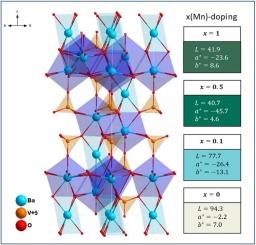Mn5+掺杂Ba3(VO4)2:颜料和荧光粉光学性质的调谐
IF 3
Q3 Physics and Astronomy
引用次数: 0
摘要
采用传统陶瓷法和溶胶-凝胶Pechini法合成了Ba3(V1-xMnxO4)2固溶体。使用x射线衍射,拉曼光谱和EPR进行结构和成分表征,从而详细了解Mn含量如何影响结构和颜色。这些化合物表现出双重光学行为:(i)由于Mn5+原子内跃迁,在可见光到近红外范围内具有强吸收;(ii)由于Mn5+和V5+的配体到金属电荷转移(LMCT),在紫外可见范围内具有强吸收。这种双重吸收产生了一个以蓝色调为中心的窄反射窗口,允许颜色根据锰浓度从淡蓝色调到深绿色。此外,低Mn含量的成分在1181.5 nm处显示出尖锐而强烈的近红外发射,尽管这种发射在高Mn含量时被强烈猝灭。这些发现突出了这些化合物作为具有有趣光学性质的稳定无毒无机颜料的潜力。本文章由计算机程序翻译,如有差异,请以英文原文为准。

Tuning optical properties of Mn5+ doped Ba3(VO4)2: Pigment and phosphor
The Ba3(V1-xMnxO4)2 solid solution was synthesized using both a conventional ceramic route and the sol–gel Pechini process. Structural and compositional characterization was performed using X-ray diffraction, Raman spectroscopy, and EPR, enabling a detailed understanding of how Mn content influences both structure and color. These compounds exhibit a dual optical behavior: (i) strong absorption in the visible to near-infrared range due to Mn5+ intra-atomic transitions, and (ii) intense absorption in the UV–visible range resulting from ligand-to-metal charge transfer (LMCT) involving both Mn5+ and V5+. This dual absorption gives rise to a narrow reflection window centered on blue hues, allowing the color to be tuned from pale blue to dark green depending on the manganese concentration. Additionally, compositions with low Mn content display a sharp and intense near-infrared emission at 1181.5 nm, though this emission is strongly quenched at higher Mn levels. These findings highlight the potential of these compounds as stable and non-toxic inorganic pigments with interesting optical properties.
求助全文
通过发布文献求助,成功后即可免费获取论文全文。
去求助
来源期刊

Results in Optics
Physics and Astronomy-Atomic and Molecular Physics, and Optics
CiteScore
2.50
自引率
0.00%
发文量
115
审稿时长
71 days
 求助内容:
求助内容: 应助结果提醒方式:
应助结果提醒方式:


